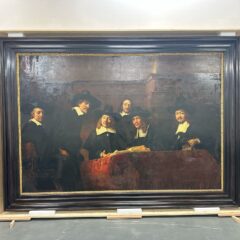Keith Haring Through a Best Friend’s Eyes

Keith Haring’s timeless artwork inspires artists across the globe and continues pushing the boundaries on how art is defined and interpreted. Haring was born in Reading, Pennsylvania in 1958, but he grew up in the neighboring town of Kutztown alongside Kermit Oswald. As Haring’s lifelong best friend, Oswald speaks to the creativity and attitude that Haring brought to his daily life and artwork. While Haring may no longer be on this Earth thinking and creating, Oswald describes his work and legacy as “immortal.”

Oswald and Haring officially met in their youth while attending a pre-kindergarten church school taught by Haring’s father. They continued to grow closer upon entering elementary school, a vivid memory Oswald still looks back on fondly. Knowing no one else on the first day of school, he was immediately drawn to the familiar young Haring with his long, wavy hair and what Oswald termed wire-rimmed “John Lenin glasses.” Haring’s looks and demeanor on the first day of school stuck with Oswald and still contribute to how he remembers Haring and his creative spirit. He reminisced on the palpable imagination and expression shown in the time that Haring and Oswald spent together. The friendship blossomed through their shared interest in art, especially drawing. The two could always be found drawing alongside each other as Oswald recalled how Haring would draw nonstop. Their mutual passion for the art form collectively inspired them and allowed them to push their personal boundaries on creation. They spurred each other on and maintained roles in each other’s lives that Oswald described as “speaking that language to each other.” He reflected on how “if you think you have a good idea, you end up bouncing that off of your best friend.” The two friends were able to grow together by lifting each other up and fostering each other’s ideas.

The friendship persevered as Haring’s art took him to New York City, a bustling hub of creativity and up-and-coming artistic talent. Oswald reflected on how limiting a small town can be for someone like Haring, who was full of ideas and aspirations. Haring was someone who always advocated for what he believed in, an aspect of his personality that Oswald argued began at a very young age, then “permeated his entire life.” That advocacy carried into the magnetic pull of New York City, a place Oswald described as a “safe haven” for people looking to fit in or find others with similar interests. After attending the School of Visual Arts in the city, Haring became very involved in New York’s network of artists and free expression. He was able to engage with creative people ranging in personality, expression, and artistic medium. Oswald also explained how New York City was able to offer a sense of freedom—especially in terms of sexuality—that small towns may struggle to offer. Haring’s beliefs and advocacy carried into his activism through his art, especially on the city streets of New York.

However, those interpreting Haring’s work may not be seeing his humor poking through, Oswald argued. Haring was one of the funniest and most positive people he knew. He speculated that Haring had been using his artwork to help people see deeper meanings that may not be apparent to them in their daily lives. Oswald believes that some of Haring’s pieces have darker, more serious tones to them, but that it is important to look at how some artists may create work with weighted meanings and still be some of the happiest, most forward-thinking individuals. Oswald often reminisces on something Haring used to always say: Haring always “wished he didn’t have to sleep.” He was someone Oswald said loved people, life, his family, his country, and his friends—an aspect of his personality that made him a fantastic godfather to Oswald’s children. Haring worked tirelessly and never stopped creating, doing, and living. “This was someone who was so … in love with what he was doing that his only regret in life, he said, he had to go to bed at night and stop doing it.”

According to Oswald, the role of an artist is to teach observers something they had not previously considered. For those able to fulfill that role and do it well, “the work and the individual become immortal.” Artists that can impart legacies riddled with lessons are in turn never forgotten by those who have learned from them. Their paintings and artwork become globally revered, ending up in museums and exhibits that forever preserve the success of the artist. “For someone like him coming from a really small town, to be able to accomplish that … you can’t imagine how wonderful that is.”







